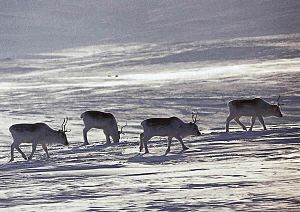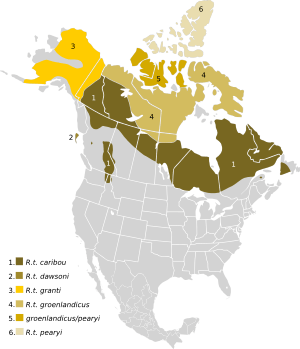Peary caribou facts for kids
Quick facts for kids Peary caribou |
|
|---|---|
 |
|
| Peary caribou | |
| Conservation status | |
| Scientific classification |
|
| Kingdom: | Animalia |
| Phylum: | Chordata |
| Class: | Mammalia |
| Order: | Artiodactyla |
| Family: | Cervidae |
| Subfamily: | Capreolinae |
| Genus: | Rangifer |
| Species: | |
| Subspecies: |
R. t. pearyi
|
| Trinomial name | |
| Rangifer tarandus pearyi (Allen, 1902)
|
|
 |
|
| Approximate range of Peary caribou. Overlap with other subspecies of caribou is possible for contiguous range. 1. Rangifer tarandus caribou, which is subdivided into ecotypes: woodland (boreal), woodland (migratory) and woodland (montane), 2. R. t. dawsoni (extinct 1908), 3. R. t. granti, 4. R. t. groenlandicus, 5. R. t. groenlandicus/pearyi, 6. R. t. pearyi | |
The Peary caribou (Rangifer tarandus pearyi) is a type of caribou found in the far northern Arctic islands of Nunavut and the Northwest Territories in Canada. These caribou are the smallest in North America. Female Peary caribou usually weigh about 60 kg (130 lb), while males weigh around 110 kg (240 lb). Females are about 1.4 m (4 ft 7 in) long, and males are about 1.7 m (5 ft 7 in) long.
Like other caribou, both male and female Peary caribou grow antlers. Males grow their antlers from March to August. Females grow theirs from June to September. The soft, furry covering on their antlers, called velvet, is gone by October for both sexes. In winter, their fur coat is white and thick. In summer, it becomes shorter and darker, looking almost slate-grey. This coat is made of hollow hairs, which trap warm air and keep the caribou warm.
Contents
Life Cycle and Habits
Reproduction
Male Peary caribou can start having babies when they are two years old. Females are ready to reproduce when they are three years old. They breed in the fall, but only if the female has stored enough fat in her body. A female caribou is pregnant for seven to eight months. She usually gives birth to one calf.
What They Eat
Peary caribou eat most of the plants they can find. This includes grasses, Cyperaceae (sedges), lichen, and mushrooms. They especially like a plant called purple saxifrage. In summer, their muzzles (noses and mouths) can turn purple from eating these plants! Their hooves are sharp and shaped like a shovel. This helps them dig through the snow to find food.
Travel and Predators
These caribou usually do not travel more than 150 km (93 mi) between their winter and summer feeding areas. They are very fast runners, which helps them escape their main predator, the Arctic wolf. Peary caribou are also good swimmers. They usually travel in small groups. In summer, a group might have up to twelve caribou, but in winter, groups are often as small as four.
Appearance
Fur Coat
In winter, the Peary caribou's fur gets thicker and turns whiter. In summer, their fur is shorter and darker. Their winter coat is white, and their summer coat is slate-grey with white legs and belly. This is similar to the barren-ground caribou found in the Dolphin-Union caribou herd, though the Dolphin-Union caribou are a bit darker. The hollow hairs in their fur help to trap warm air, keeping them insulated and warm.
Antlers
The antlers of Peary caribou and Dolphin-Union caribou have a light slate-grey velvet covering. This is different from the barren-ground caribou and boreal woodland caribou, whose antler velvet is dark chocolate brown.
Where They Live
Peary caribou live on the High Arctic islands of Canada. These islands include Banks Island, Prince of Wales Island, Somerset Island, and the Queen Elizabeth Islands. They move seasonally, traveling up to 150 km (93 mi) each way.
In summer, they look for areas with the most plants. These rich plant areas are often found on the upper slopes of river valleys and uplands. In winter, they stay in places where the snow is not too deep. This includes rugged uplands, beach ridges, and rocky outcrops.
Aulavik National Park on Banks Island is also home to Peary caribou. The Thomsen River flows through this park. It is the northernmost river in North America that you can travel by canoe. Aulavik National Park is a fly-in park that protects about 12,274 km2 (4,739 sq mi) of Arctic lowlands. In the Inuvialuktun language, Aulavik means "place where people travel." People have hunted caribou in this area for over 3,400 years, from ancient cultures to today's Inuvialuit people.
Peary caribou were once seen in northern Greenland, likely having wandered from Ellesmere Island. The last time they were reported there was in Hall Land in 1922.
Protecting Peary Caribou
The number of Peary caribou has dropped a lot. In 1961, there were over 40,000 caribou. By 2009, there were only about 700 left. This big drop is likely due to changes in the weather. The number of days with temperatures above freezing has increased. This causes layers of ice to form in the snow. These ice layers make it very hard for the caribou to dig for food.
Because of these challenges, the Peary caribou were listed as "threatened" in April 1979. In May 2004, the Committee on the Status of Endangered Wildlife in Canada (COSEWIC) changed their status to "endangered." This means they are at very high risk of disappearing forever.
The Peary caribou are called tuktu in Inuinnaqtun/Inuktitut. In Inuktitut syllabics, it is written as ᕐᑯᑦᓯᑦᑐᒥ ᑐᒃᑐ. These caribou are an important food source for the Inuit people. The caribou were named after an American explorer named Robert Peary.


